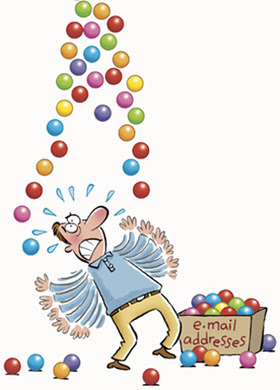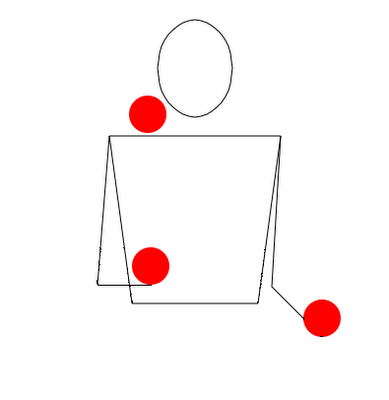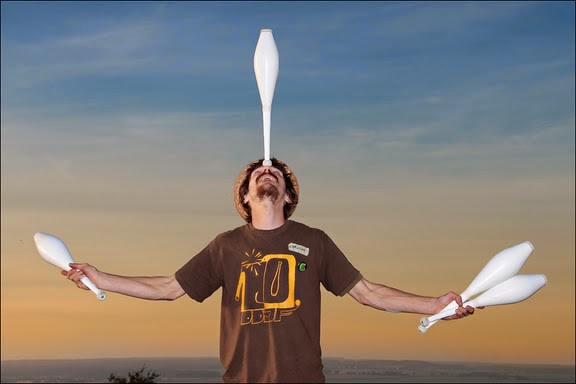
Hier wird die Gala Show zur Jonglierconvention sein, im Wechselbad der Gefühle Maternistraße 17, 01067 Dresden !
http://www.jonglieren-dresden.de/




These instructions will teach you exercises so you can juggle 3 balls. The first few exercises are not complete juggling patterns, but are exercises that will teach you to juggle.
 One Ball Exercise: Start with one ball. Throw the ball in an arc from hand to hand about eye level. The pattern will be an arc, not a circle.
One Ball Exercise: Start with one ball. Throw the ball in an arc from hand to hand about eye level. The pattern will be an arc, not a circle.
 Two Ball Exercise:Start with one ball in each hand. First toss the ball in your right hand (1) in the arc to about eye level to your left hand. When this ball (1) reaches the highest point in it's arc . . .
Two Ball Exercise:Start with one ball in each hand. First toss the ball in your right hand (1) in the arc to about eye level to your left hand. When this ball (1) reaches the highest point in it's arc . . .

 throw ball (2) in an arc from your left hand to your right. Catch (1) in your left hand, Then catch (2) in your right hand. Stop.
throw ball (2) in an arc from your left hand to your right. Catch (1) in your left hand, Then catch (2) in your right hand. Stop.

 Do this same exercise, except start with your left hand instead of your right. Practice until you can do this smoothly.
Do this same exercise, except start with your left hand instead of your right. Practice until you can do this smoothly.
 Common mistakes include throwing two balls in a circle, or throwing both balls at the same time.
Common mistakes include throwing two balls in a circle, or throwing both balls at the same time.
 Juggling 3 Balls: Start with 2 balls in one hand (1&3) (in this case the right hand, but if you are a lefty, use your left hand) and one ball (2) in the other. Start by throwing the ball in the front of your right hand in an arc to your left hand.
Juggling 3 Balls: Start with 2 balls in one hand (1&3) (in this case the right hand, but if you are a lefty, use your left hand) and one ball (2) in the other. Start by throwing the ball in the front of your right hand in an arc to your left hand.
 When ball (1) reaches its highest point, throw the ball in your left hand (2) in an arc to your right hand. Catch (1) in your left hand. This is like the two ball exercise. When the ball thrown to your right hand reaches its height . . .
When ball (1) reaches its highest point, throw the ball in your left hand (2) in an arc to your right hand. Catch (1) in your left hand. This is like the two ball exercise. When the ball thrown to your right hand reaches its height . . .
 Throw the ball from your right hand (3) in an arc to your left hand. Catch (2) in your right hand. This move can be difficult. It is often helpful to roll the ball (3) in your right hand to the front of your hand with a slight downward motion of the hand before you throw it.
Throw the ball from your right hand (3) in an arc to your left hand. Catch (2) in your right hand. This move can be difficult. It is often helpful to roll the ball (3) in your right hand to the front of your hand with a slight downward motion of the hand before you throw it.

 When that ball (3) reaches its highest point, throw the ball in your left hand (1) in an arc to your right hand. Catch (3) in your left hand. And so on . . .
When that ball (3) reaches its highest point, throw the ball in your left hand (1) in an arc to your right hand. Catch (3) in your left hand. And so on . . .
Problems and Solutions:
 The Half shower: Instead of having the balls cross in the standard 3 ball pattern, throw a ball from the right hand over the rest of the pattern. When it comes down, continue juggling. Do this for a throw or every throw; from either hand, or both hands.
The Half shower: Instead of having the balls cross in the standard 3 ball pattern, throw a ball from the right hand over the rest of the pattern. When it comes down, continue juggling. Do this for a throw or every throw; from either hand, or both hands.
vom 05.03.2010 18:00 Uhr bis zum 07.03.2010
Margon-Arena Dresden, Bodenbacherstr. 154, 01277 Dresden
3 Tage Jonglieren, Akrobatik, Einrad, Workshops, Spiele, Show, Party, Frühstück, Schlafen in Schlafhallen (Isomatte/Schlafsack mitbringen).
Natürlich wird es eine Tageskasse geben, aber günstiger ist die Anmeldung vorab:
Die Anmeldung beinhaltet im Moment freien Eintritt an allen drei Tagen und die Möglichkeit in der Halle mit Schlafsack zu übernachten, Frühstück (dieses mal wird's wieder leckerer als letztes Jahr!), kostenlose Teilnahme an den Workshops und freien Eintritt zur Gala-Show! Wobei die Galakarten abgezählt sind, falls die Galaplätze alle vergeben sind, wird dieses hier bekannt gegeben.
--> Anmeldungsformular <--
Anmeldegebühr bis zum 17.2.2010:
22 Euro (Kinder 6-16 Jahre: 18 Euro)
Telefon: 03 51-8 30 94 39 (Gesa)
Email: ptheeg@gmx.de (Peter Theeg)
--> Anfahrskarte
Straßenbahnhaltestelle (Line 1 und 2): Prof.-Ricker-Straße
--> Verbindungsauskunft

Allerdings wann jetzt der eigendliche Jahrewechsel ist, kann jeder selbst entscheiden. Mein Gefühl sagt mir, zum Frühling, wenn die Natur wieder grün wird.
"Frohes Neues Jahr"!
~~~~~~~~~~~
Das Foto entstand mit Sven Bartsch als Photograph und mir als Performer in Oschatz Dez. 2009. Und wurde von der OAZ (Oschatzer Allgemeine Zeitung) als Titelfoto zur Jahreswende 2009/10 genommen.


